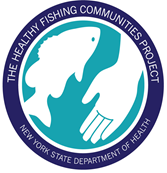Project Information Sheet
Att7_ProjectInfoSheet.docx
Biomonitoring of Great Lakes Populations Program II
Project Information Sheet
OMB: 0923-0052
Attachment 7. Project Information Sheet
Healthy Fishing Communities Project
This project aims to measure the amount of chemicals and metals in
people who eat fish caught from the Great Lakes tributaries.


Who is conducting this project?
This is a joint project between the federal Agency for Toxic Substances and Disease Registry (ATSDR) and New York State Department of Health (NYS DOH).
What is biomonitoring?
Biomonitoring is the assessment of human exposure to contaminants by looking for them in human specimens, such as blood or urine. Blood, serum, and urine levels reflect the amount of a contaminant that actually gets into the body by all routes of exposure, including ingestion, inhalation, and dermal absorption. Once these contaminants enter the body, some are stored in body fat and it may take years for the body to get rid of them.
What will be tested for in my blood and urine?
NYS DOH labs will test your blood and urine for the following chemical mixtures: PCBs, PBDEs, PFOS and PFOA, and pesticides (mirex, toxaphene, chlordane, hexachlorobenzene, DDT, and DDE). Some of these chemical mixtures were banned many years ago but still exist in fish and other food sources because they do not break down in the environment and can build up in our bodies. The metals that will be tested for are mercury, lead, and cadmium. You will be sent the results from some of your blood and urine tests with information about what they mean.
How will I be eligible to participate?
You will be eligible if you are 18-69 years old, live in the City of Syracuse, ate fish caught in Onondaga Lake or tributaries, and received a referral coupon from someone you know.
Will my information remain secure?
Yes, all information about you (including your name and address, the screening survey, your interview answers, and your blood and urine test results) will be kept secure. We keep track of your information using a code number rather than your name. All personal identifiers will be removed before specimens are sent to the laboratory.
What kinds of questions will I be asked and how long is the procedure?
If you are eligible and give consent to participate, you will be asked detailed fish consumption questions during the interview (where the fish was caught, what species, how often it was eaten, and how the fish was cooked/prepared). You will also be asked questions such as your occupation, reproductive history (if female), and tobacco use. You can refuse to answer any of the questions or withdraw from the project at any time for any reason. The interview and sample collection should take no longer than one hour. After the appointment you will be compensated for your time and effort with a thank you gift card.
Should I stop eating fish or worry about adverse health effects from these contaminants?
No, fish are an excellent source of protein, omega-3 fatty acids, and other essential nutrients. There are many scientific studies that show there are various health benefits to eating fish such as heart, brain, immune, skin, and eye health. Even if you have measurable levels of these contaminants in your body, it does not mean you will develop disease. Your individual data (identified by code number) will be grouped with other participants’ data to help determine appropriate fish advisories in NYS and will be used to inform policy on reducing Great Lakes contaminants. To reduce your exposure to Great Lakes contaminants, you should continue to follow the NYS fish advisories posted at
http://www.health.state.ny.us/environmental/outdoors/fish/fish.htm
If you have any further questions, please contact:
Ms. /Mr.
Project Coordinator
New York State Department of Health
Center for Environmental Health
ESP, Tower Room 1203
Albany, NY 12237
518-402-7950 FAX: 518-402-7959
| File Type | application/vnd.openxmlformats-officedocument.wordprocessingml.document |
| Author | Julie A. Reuther |
| File Modified | 0000-00-00 |
| File Created | 2021-01-26 |
© 2025 OMB.report | Privacy Policy